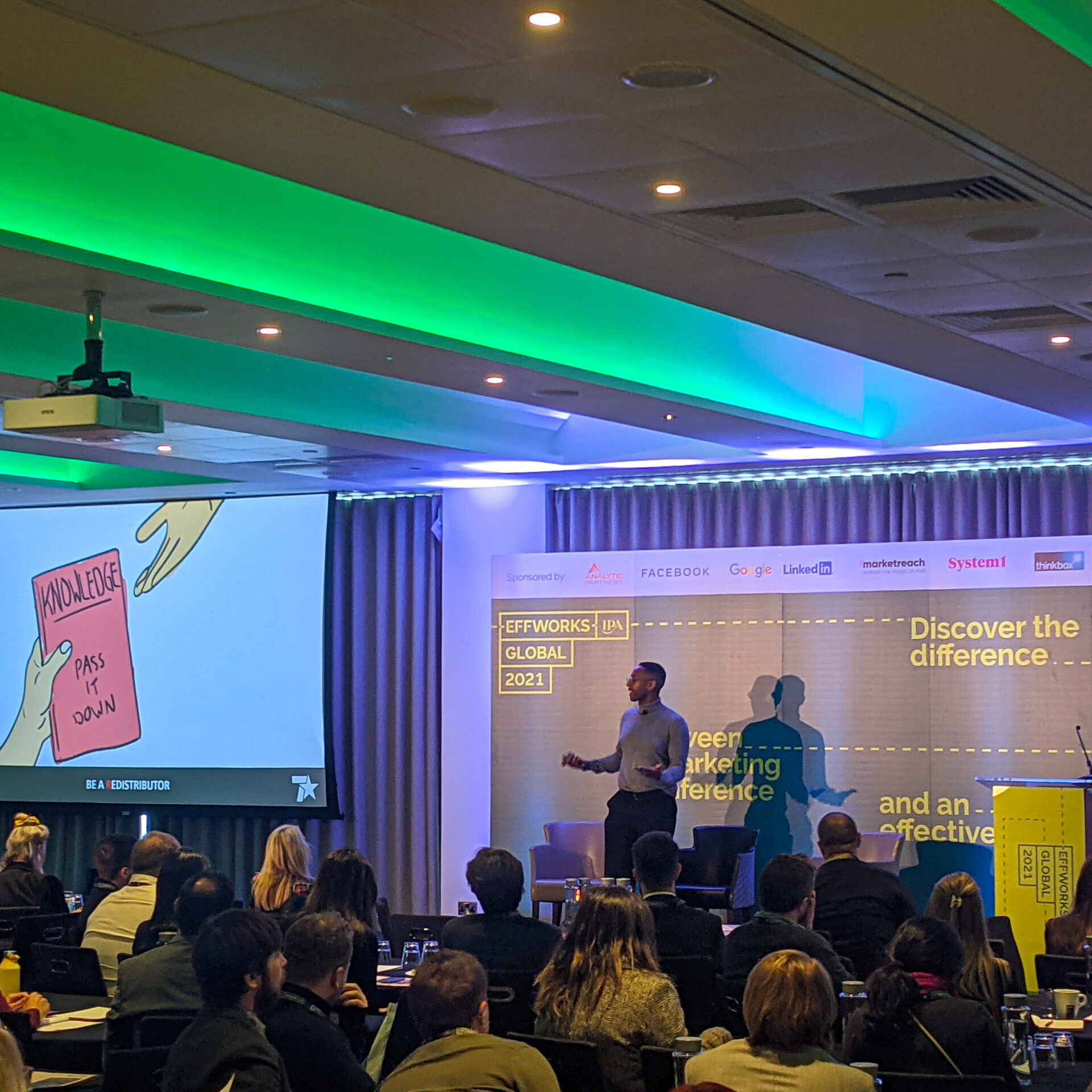
Over four days, the IPA unveiled a fresh batch of research into marketing effectiveness. the7stars were on hand (physically and virtually) to sift through the new evidence and pull out the key learnings for advertisers.
The ‘Double Jeopardy’ Rule has been quantified. And scale ups and challengers can benefit twice.
A new meta analysis of 343 econometrics studies led by Grace Kite added significantly to the effectiveness evidence bank. Over the last decade, Byron Sharp, Paul Dyson and Mark Ritson have all highlighted the role of pre-existing brand equity in determining campaign returns; but until now the ‘Double Jeopardy’ rule was an abstract concept for brands.
Leaning on econometric modelling across brands and categories, the team have identified that every £50m of underlying revenue adds an additional £0.4p of ROI. Not only does this help contextualise effectiveness findings and enable better ‘pound for pound’ comparisons across brands and industries, but it also aids outer year planning for early life-stage brands. These findings can be applied to better plot a path to profitability over successive campaigns, and more carefully phase investment as scale ups mature.
Marketers should look to employer and shareholder brand as success measures for their purpose campaigns.
Peter Field dipped into the IPA databank to add some much-needed rigour to the debate on Brand Purpose. Though the depth of evidence in the database was less than ideal – this was an important first step and some initial learnings emerged.
The key insight that purpose campaigns generated less large business effects than non-purpose campaigns was unsurprising – however the range of outcomes observed was noteworthy. Purpose does not inherently represent a barrier to effectiveness, but brands should be wary to avoid any bias for action with their campaigns. In the absence of era defining ideas (Dove, Kenco etc.), they should look at purpose as a key element of their B2B strategies, and as vehicles for employer branding. Among the cases in the databank, purpose campaigns were significantly more likely to report measurable effects on supplier reputation and investor awareness than non-purpose campaigns.
Analysts need to take centre stage to stimulate a culture of effectiveness.
Our own Tashan Nicholas discussed five ways that analysts can encourage evidence-based decision making among both agencies and advertisers.
Among his advice was a rallying cry for analysts to deepen their business knowledge and become more upstream and proactive in driving business growth. It is also necessary to take a more consultative approach and invest a greater share of time in project design and delivery than technical execution – ‘measuring thrice and cutting once.’
Analysts should also take on a multi-faceted coaching responsibilities – redistributing knowledge through their organisations to better equip decision makers in the application of evidence– ‘coaching not coaxing.’
Agencies and advertisers should create joint effectiveness roadmaps to navigate the volatile post pandemic environment.
One of the flagship reports released was the IPA’s Culture Monitor – a wide sweeping survey of marketing professionals to assess the state of the effectiveness nation. Though the report found effectiveness culture to be in good health, one standout recommendation was for organisations to create effectiveness roadmaps to further improve their cultures.
In the volatile post pandemic environment, where distribution networks and advertising consumption have been significantly disrupted – we believe it is crucial for advertisers and agencies to take this journey together.
To foster this collaborative approach to effectiveness, we are rolling out business acceleration plans across our new and existing clients in 2022. These roadmaps serve as a shared vision for growth, a joint strategy, with effectiveness at the heart of them; and aim to simplify the complex communication landscape and detail out the areas of focus that will ultimately lead to the desired business growth.
Creative has turned inward, but should advertising hold a mirror to society or put lipstick on the pig?
Orlando Wood made the compelling case that trends in advertising creative have been strongly influenced by the smartphone revolution – drawing comparison to the art produced in the shadow of the Industrial Revolution and the Reformation. Our increasing inwardness as a society is reflected in a reduction in humour in creatives, as well as increasing detachment, inwardness, barrenness, and a loss of vitality.
This point was eloquently and persuasively made, but the actions available to the industry are less obvious. Is it in the gift of creative directors to challenge broader societal trends, or must they necessarily reflect them?
‘Quality Reach’ challenge demands innovation in audience measurement.
The first client panel of the conference highlighted the challenge advertisers face in accessing quality advertising reach as media consumption fragments and pandemic audiences normalise (Kiel Peterson, Diageo). Further observations about the state of Share of Voice Measurement in the digital age (Rob Brittan) stacked on top of this to create a true challenge for brand media planning.
The application of attention measurement data to planning (explored by Karen Nelson-Field) offers one route to improving investment allocation but is insufficient for advertisers in isolation. The success of cross media measurement initiatives such as Project Origin is key to driving intelligent investment allocation as media consumption fragments and advertising products evolve. Brand managers and media planners need an agile, accurate and all-seeing audience measurement solution to plan for effective reach in the current media landscape. Much hinges on the successful scaling of Origin.
For the time being, there is a complex web of data and analytics for decision makers to navigate. Periodic survey data on consumption; isolated behavioural datasets, cumbersome incrementality measurement (often too blunt an instrument), nascent attention measurement data, and contextual opportunities, all need to be balanced to design an equation that solves for effective reach.
the7stars have already integrated Attention measurement into our Audience Planning Process (Gravity Planning), adding an extra layer of intelligence to investment allocation decisions. Attention measurement is an important leap forward, but this is a nascent field. We are continuing to test and learn to understand the role of attention in placement optimisation within specific channels, and wait patiently for media owners to facilitate a better cross media audience measurement solution.
Share of Search extension highlights poor speed to the dissemination of best practice effectiveness measurement.
James Hankins shared further research into Share of Search as an effectiveness measure – deepening the link between change in Share of Search and change in Market Share. The prominence of this work highlights wider trends in the effectiveness measurement sector, however.
Brand Search and relative Share of Brand Search were commonly used metrics among effectiveness analysts even before the influential book ‘Everybody Lies’ was published in 2017. A lack of open discussion regarding best practice characterises the worlds of marketing mix modelling, attribution, and marketing experimentation; and makes for an overwhelming supplier landscape for advertisers and procurement professionals to navigate. Forums such as EffWorks help to progress the debate, and media owner teams such as Facebook’s have helped to foster increased intelligent debate – but lack of codification and common training standards represents a barrier to progressing measurement standards beyond search intent and towards long term profit.

On the evening of Tuesday 14 September, the consultation period on the future of Channel 4 came to an end. A consultation designed to test the government’s belief “that a new ownership model for Channel 4 would be the best means of ensuring its future success.”
Channel 4 is currently publicly owned but commercially funded. Which means the taxpayer doesn’t fund it, but it’s not required to turn a profit or focus on shareholder dividends in the way private companies are. So, profits are re-invested into programming, allowing the creation of content other channels might view as risky or unprofitable. This in turn allows Channel 4 to deliver against its public service remit of serving diverse and under-represented communities, along with supporting independent British programme makers.
A central concern to those against privatisation is that this element of Channel 4’s offering may be lost. Ampere Analysis found that Channel 4 uses 200 different UK based production companies, 140 of them reliant on Channel 4 for more than half of their TV production work. Each one of these companies brings a new perspective and develops talent which benefits the entire industry. A private owner tasked with maximising profits is likely to reduce the breadth of production companies and the level of risk taking within programming.
Proponents of privatisation argue that new investors with deeper pockets could mean bigger budget programming being brought to British screens. Shortly before losing his job, the culture secretary Oliver Dowden said this meant Channel 4 would be in a better position to take on the streaming giants and to bring in more event programming such as Emma Raducanu’s US Open final. Which perhaps overlooks the fact that Channel 4 were able to do just that under their current model, despite making no return on the ad-free feed from Amazon.
Any change in ownership for Channel 4 as an advertising environment could mean bigger shows, more event programming, and could well pull in larger viewing numbers, providing new opportunities to drive cost effective reach. But the danger is that Channel 4 starts to look a bit more like other channels, which might mean the relatively unique TV audience it currently attracts is diluted. Another consideration for media opportunities is that ITV is currently being mooted as a potential buyer for Channel 4. This reduction in TV sales houses, and the market dominance granted to the new entity, has already been highlighted by ISBA as a concern for advertisers.

Whichever way you spent it, it’s safe to say Christmas in 2020 was a lot different to previous years. With the nation having spent most of the year apart from friends and family, and with coronavirus cases on the rise again, an initial plan to relax lockdown restrictions over the festive period was drastically scaled back – and, for those living in tier four areas, scrapped entirely.
It was little surprise, then, that last year’s Christmas didn’t feel the same. There were no office parties; no long lines for Boxing Day sales. Far from the usual festive feast, food sales declined by 3.4% in the month to December. A staggering eight million Brits spent Christmas Day alone.
After the trauma of last year, one question on most brands’ minds: is Christmas back in 2021?
By delving into a wealth of research and proprietary learning, the7stars has sought to answer that question in our Christmas Trends 2021 whitepaper. The team have identified three over-arching themes which are set to define this year’s festivities, for a Christmas like no other:
Anticipation: After celebrating from a distance last year, consumers are hoping to make the most of this Christmas, with plenty of family reunions and splurging of lockdown savings to celebrate.
Meaning: Over lockdown, Brits found themselves craving closeness and felt more in touch with their sentimental side. This is likely to continue, with a focus on personalised gifts and the relationships that matter most this Christmas.
Impact: The pandemic led many to reappraise what’s important in life, with environmental and social ramifications more apparent than ever before. This year’s festivities are likely to play out in the same context, with Brits dreaming of a greener, cleaner and fairer Christmas in 2021.
Of course, there remain some things which will never change. Christmas crackers will still be pulled; carrots will continue to be crunched. But the impact of lockdown will likely still be felt.
One year on from ditching their usual shopping habits, online orders are poised to rule the roost again this year, with half of Brits intending to shop online at the same levels as during lockdown. However, shoppers could face difficulties getting their presents delivered in time, should global supply chain issues – exacerbated by the UK’s HGV driver shortage – continue into Christmas.
And while those who built up savings over lockdown expressed a willingness to splurge, families with lower disposable income may opt for a smaller, more considered Christmas again this year.
Gen Z, in particular, dream of a Green Christmas, with 56% intending to celebrate in an eco-friendly way, compared to 1 in 4 of those aged 55+. By shifting towards more plant-based and sustainable materials, this group are looking for innovative products to define their experience.
While some Christmas rituals will return, not everything will go back to the way it was. Brits still crave a holly, jolly Christmas, sure – but one that leaves a lasting, positive impact on their world.

Once upon a time, adverts had a pretty good idea of the company they might keep. An ad for a watch might sit in the business section of the newspaper. The car advert was placed on a roadside billboard.
But digital changed things. It allowed us to place ads according not only to the content they would sit alongside, but also to who was reading that content. Being able to track behaviour online meant knowing a lot more about the people landing on any given page at any given time. So, ads could be placed against people rather than places. The big advantage of this being that ads could then be bought against the right person, but on lower cost websites and sections of sites.
There has always been great debate about how effective this approach is. It was often cited that products advertised in higher priced media contexts were themselves perceived as being of higher value. This debate has now entered a new phase as Google plans to phase out 3rd party cookies by the end of the year – a move likely to inhibit some forms (and providers) of behavioural targeting.
The release this month of a study looking at the importance of context could hardly be more perfect. Integral Ad Science analysed the impact content surrounding a banner ad has on the effectiveness of the advert itself. Participants were asked to browse pre-selected articles on eight different sites. They were shown one article and one ad per site. Four ads were shown alongside unmatched content, the other four across content which matched either the article theme or message.
Results showed that 73% of people found an ad more appealing when it was related to the content of an article. They also found a 25% uplift in memorability when an ad matched the theme of the content it sat alongside.
Diving a little deeper into the numbers, the study uncovered that adverts which contain a great deal of information benefit most from sitting alongside content that matches on an endemic level (meaning the ad solves a problem the article creates – e.g. an ad for a film on a film listings page). Whereas ads that appeal on a more emotive level see greater benefits from sitting alongside content sharing the same theme.
It’s another piece of evidence to suggest that context, where your ad is sitting and what appears beside it, all impact performance. Moreover, it will serve as a guide for how to navigate targeting choices when online behavioural tracking becomes more limited.

After 18 months of uncertainty and upset across the advertising marketplace, we still managed to be surprised by the never-seen-before inflation levels that September brought to AV.
Understandably, advertisers have emerged from the slumps of 2020 to thankfully spend again and revive the marketing industry. Year-on-year figures have looked buoyant throughout recent months but in September, the huge revenue hikes sent everything off balance.
All three big players in AV saw excessive inflation, ITV and Sky with circa 20% year-on-year and C4 at circa 40% year-on-year which, having caught the industry off guard meant the need for the implementation of diverse solutions.
There are many reasons behind the unprecedented inflation, but three factors were key. The first being the relaxing of Advance Booking Deadlines across the industry, something which the7stars has always benefited from, but with large network agencies permitted this short-term perk, late money had entered the market at no penalty, skewing forecasted revenue figures.
Secondly, the number of brands advertising on TV was significantly higher than in 2019. Many advertisers had held back on spending until post lockdown, as well as choosing to avoid months when the Olympics and the Euros were on air, aiming to benefit from the more regular TV schedule (with programming such as Bake Off), and ultimately hoping for pricing to stabilise. Unfortunately, conversely, the additional market revenue together with impacts falling year on year, as more people are back at work and going on holiday, resulted in price inflation.
Thirdly, one of the main drivers behind the excessive Channel 4 inflation was the result of over-investment on ITV for Euros coverage and the return of the summer series of Love Island UK.
To alleviate these market pressures on campaigns, we identified solutions through our ability to be highly agile and flexible in the market; moving marketing spends into more lucrative environments, within sales houses for example, from linear into BVOD where pricing fluctuations do not occur and moving budgets from AV into other media channels where pricing is not impact and revenue adjusted.
Looking forward to Q4, we will no doubt see a bountiful period for advertising and may need to think fast with solutions for continuing year-on-year inflation, but we should view this in a positive light as brands have the overdue revival they have so desperately needed, after such punishing times.
Linear TV channels have an optimistic Autumn/Winter ahead with Channel 4 in particular showcasing an exciting programming slate, so we are anticipating favourable viewing figures which can hopefully stabilise any future revenue spikes.
With AV consumption and advertiser spending surely levelling out from here on in, we should see a more balanced 2022 with market changes based on trends from 2019.

Ever been heartbroken at the news of a celebrity couple’s divorce? Perhaps Brangelina’s split, Prince Charles’ affair or Kim & Kanye’s recent parting drew up a well of emotions in you?
Research defines celebrity-fan relationships as parasocial, wherein fans feel an intense and familiar connection to celebrities despite the relationship often being one-sided and mediated over mass media channels. Such a phenomenon was born during the 1950’s and 60’s when the Golden Age of Hollywood first catapulted starlets and heartthrobs onto the screen. However, the transition towards multimedia channels has evolved a breed of ‘superfans’, or ‘stans’ who now have access to a foray of personal information about celebrities and influencers thanks to the scope, constant feedback loop and direct communication lines of social media. The boundary between private and public blurs so much that fans have begun to enter the personal space of their idols digitally, impassioning keyboard warriors to ‘protect’ and ‘support’ during controversies and even liken celebrities to family – brothers, sisters, mothers and fathers whose image, behaviour and personality they can shape beyond normal celebrity worship. This hyper form of fan culture is known as parakin relationships.
Classic examples are arguably more prevalent in collectivist societies where people have one idealised standard and subsequently quash down public figures who sought after individuality or deviate from the norm. For fans who source much of their self-identity from celebrities, influencers and their respective fandoms, fans feel the need to control their idols’ image to coincide with their own sense of self. In return, fans can escape from their reality and exaggerate the confines of their daily lives. Whilst normal fans create fanart – drawing or painting images of their idols, superfans create and shape the celebrity themselves.
But why is this important and what does it even mean for brands?
In the branded world, co-collaboration and creation with fans is celebrated and often strategic. If celebrities and influencers can be seen as personal brands themselves, earning much of their revenues from likes, shares and comments online, perhaps it’s not so much of a surprise to see fans co-create with public figures in the same way? In fact, this points to a natural desire for devoted fans to want to co-create with branded communities. Celebrities such as Taylor Swift held a ‘Secret Session’ concert in her own home, whilst Tom Daly leverages the digital channel Patreon to provide insight into his personal life, and consequently foster the relationship to his advantage. American start-up ‘Community’ have even developed a one-to-one messaging platform for musicians to message their fans directly. If used positively, stans’ fervour and loyalty can be capitalised, such as in the case of Game of Thrones where 1.7 million people signed a petition to remake the 8th season. Similarly, Rihanna’s personal perfume ‘Baccarat Rouge 540′ went viral on TikTok, reflecting the fans desire to embody her and boosting sales. What remains clear is that super fans’ strength in numbers, passion and assertiveness can change the game, and make big business.
Source: Canvas8

After what has been a well-documented difficult eighteen months for young people, this month, students have been returning to universities up and down the country as campuses re-open and Freshers’ Weeks begin. Many will have been caught up in the pandemic A-levels fiasco, whilst others will have already begun their university experience with online learning, little face-to-face contact and the mental and emotional strain that this brings.
Whilst government advisers have warned that Freshers’ Week festivities may bring about a spike in covid cases, students appear undeterred by the threat of a winter surge, with 2021 seeing a record number of young people accepting university places. With 87% of students planning to get vaccinated ahead of the start of term, students seem positive about the future; according to YouGov, 32% believe that it is unlikely new restrictions will be introduced in the autumn, versus 25% of the population as a whole.
the7stars QT national tracking study further reveals that Gen Z’s are the driving force behind current UK happiness levels with 62% of 18-25s happier than this time last year. Given this optimism, it’s no surprise that students are keen to make up for missed opportunities, friendships and experiences after a year of closed campuses. According to HiveMindMarketing, 52% claim that the pandemic has made them more intent on returning to a normal university lifestyle, whilst Redbus Media report that 63% plan to socialise more this academic year. Students have long been considered a distinctive and attractive target audience. As they fly the nest, many lack established relationships with brands, having moved away from the preferences of their families and parents.
In a new environment and in their formative years, they are open-minded and ready to form new brand loyalties. Research shows these are often long-lasting, with many remaining loyal to brands that they first purchased at university. With students more determined than ever before to get out, spend and engage with the world around them, this offers brands a great opportunity to capitalise on their optimistic spirit. With their appetite for experience, now is the perfect time to follow the lead of others – Nando’s, Red Bull, Wagamama, who in July ran a two-day student katsu curry giveaway and Papa John’s, who’ve recently collaborated with student favourite, Depop – who have entrenched themselves in student culture having recognised the opportunity, and start to initiate long-term relationships with this highly valuable audience.



Recent Comments